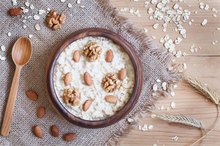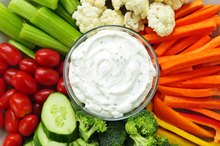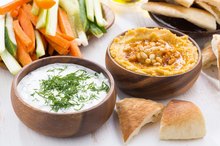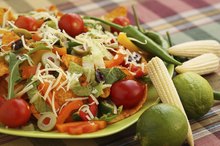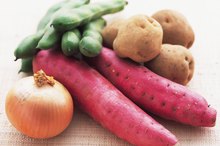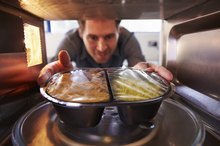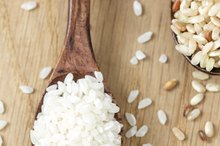7-Week Diet Plan
To be healthy and sustainable, a seven-week diet plan needs to do more than simply restrict your daily caloric intake. It should provide a balance of all the food groups your body needs to obtain essential nutrients – whole grains, lean protein, fruits, vegetables and high-calcium foods like dairy – while being easy enough to follow without strenuous effort. One way to do this, suggests the U.S. Department of Agriculture, is to follow a basic template that divides your recommended servings and portions for each meal throughout the day. You won’t need to guess what you’re eating every day for the plan’s seven weeks, and you can be certain to consume enough for proper health without going overboard. Ask your doctor if you need help designing a diet that works for you.
Sample Breakfast Plans
You might plan breakfasts on your seven-week plan to include a 1-ounce serving of grains, 1 cup of low- or nonfat dairy or other calcium-rich food and 1 1/2 ounces of protein. A slice of whole-wheat toast topped with peanut butter and roasted, unsalted sunflower seed kernels paired with a glass of milk or a calcium-fortified plant milk such as almond or soy milk would fulfill these requirements. Other good breakfast grain options could be cooked oatmeal, a whole-wheat bagel or a ready-to-eat cereal that has 3 or more grams of dietary fiber and less than 240 milligrams of sodium and 7 grams of sugar per serving. Steer clear of high-fat breakfast meats like bacon, sausage or ham in favor of poultry-based alternatives.
Sample Lunch Plans
2,000-Calorie ADA Diet Plan
Learn More
During your seven-week diet, a typical lunch menu could consist of two 1-ounce servings each of protein and grains, 1 cup of vegetables and 1/2-cup serving of dairy. One sample lunch could be a sandwich containing 2 ounces of turkey breast or lean roast beef and reduced-fat cheese with a side salad. Another option might be a pasta salad containing grilled chicken breast or tofu and chopped raw vegetables served with milk. Choose whole grains like whole-wheat bread or whole-grain pasta over refined-grain choices such as white bread, regular pasta and white rice. They contain more nutrients, including fiber, which can aid with weight loss by keeping you feeling fuller longer. If you’re a vegan, strict vegetarian or lactose-intolerant, you can get the calcium you need by substituting fortified plant milk, juice or bread products or including plenty of dark, leafy green vegetables in your diet.
Sample Dinner Plans
For dinners, plan on a balance of all the food groups. Try two 1-ounce servings each of protein and grains and a 1-cup serving each of vegetables, fruits and calcium-rich foods. Serve 2 ounces of grilled salmon with 1 cup of cooked brown rice, steamed vegetables, fresh seasonal fruit and a glass of milk, or have a meal such as two whole-wheat tortillas filled with sauteed pork loin and topped with shredded cheese and your choice of raw or sauteed vegetables. Vegetarians might have a lentil, kale, vegetable and barley stew with a whole-grain roll. Round out the meal with a dessert of fresh fruit. To keep your fat and calorie consumption as low as possible, don’t fry your meats, coat them with breading or eat them with creamy, high-calorie sauces. Instead, pick grilling, roasting, broiling or steaming, and use as few heart-healthy mono- and polyunsaturated fats like olive or canola oil as possible.
Sample Snack Plans
Mayo Clinic 1,200-Calorie Diet
Learn More
Wise snacking can help you achieve success during your diet by helping you stave off hunger while supplying much-needed nutrition. Snacking poorly on chips, cookies, candy, commercial baked goods, fried foods or buttery popcorn, however, can pack on empty calories and inhibit weight loss. Plan for two nutrient-dense, low-calorie snacks each day -- one midmorning and another in the late afternoon. Include at least two of the food groups in each snack. For example, your midmorning snack might contain one fruit serving and 1/2 cup of dairy, such as sliced fresh fruit mixed into nonfat, unsweetened yogurt. Your afternoon snack could contain a serving of grains and 1/2 cup of vegetables. Five whole-wheat crackers paired with raw vegetables like carrots, broccoli or celery would be a good choice.
Related Articles
References
Writer Bio
Michelle Kerns writes for a variety of print and online publications and specializes in literature and science topics. She has served as a book columnist since 2008 and is a member of the National Book Critics Circle. Kerns studied English literature and neurology at UC Davis.
